 Today starts the 2025 Memorial Day weekend here in the United States.
Today starts the 2025 Memorial Day weekend here in the United States.
This coming Monday is Memorial Day, a federal holiday in the United States for remembering those who have made the ultimate sacrifice while serving in our country’s armed forces.
This entire three-day weekend is about a lot more than barbecues, baseball and the beach, and it’s not a patriotic celebration of military might, it is a remembrance of the 1 million plus casualties of all our wars who never made it home.
National Moment of Remembrance
The “National Moment of Remembrance” resolution was passed in December of 2000 and asks that at 3 p.m. local time on Memorial Day, for all Americans “To voluntarily and informally observe in their own way a Moment of remembrance and respect, pausing from whatever they are doing for a moment of silence or listening to ‘Taps.”
Here are some additional ways that you can honor the men and women who have made the ultimate sacrifice for our country:
- Put flags or flowers on the graves of men and women who served in wars.
- Fly the U.S. flag at half-staff until noon.
- Visit monuments dedicated to soldiers, sailors and marines.
- March in or attend a parade.
HONOR. REMEMBER. NEVER FORGET.
Your stories to close out the week...
Pilot makes emergency belly landing at Arlington airport
No injuries were reported after the emergency landing on Thursday.
By NBCDFW Staff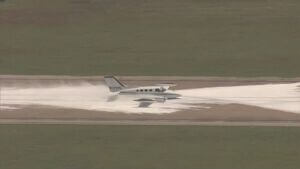
The pilot of a twin-engine Cessna made an emergency belly landing at Arlington Municipal Airport on Thursday.
With gears retracted, the pilot touched down on a foam-covered runway at about 12:42 p.m. and slid to a stop.
A few moments later, two people exited the aircraft with their luggage and walked away, apparently uninjured.
John Illson, an aviation safety expert with decades of commercial airline experience as a captain and advisor to the FAA, said foam is generally applied to runways during abnormal landing situations to reduce fire risk.
FAA records show the aircraft, a 1967 Cessna 401, registered to an owner in Denton.
https://www.nbcdfw.com/news/local/emergency-belly-landing-arlington-airport/3847232/
What we know about a private plane's fatal crash into a San Diego neighborhood
The private jet crashed into a San Diego neighborhood of U.S. Navy-owned housing during foggy weather, igniting at least one home and numerous vehicles.
By Julie Watson | The Associated Press
The music agency Sound Talent Group said 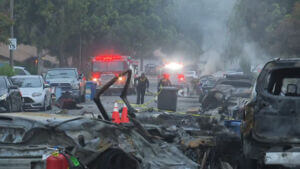 Thursday that three of its employees, including co-founder Dave Shapiro, died on the private plane that crashed into a San Diego neighborhood.
Thursday that three of its employees, including co-founder Dave Shapiro, died on the private plane that crashed into a San Diego neighborhood.
Shapiro is listed as the owner of the plane and has a pilot’s license, according to the Federal Aviation Administration. Shapiro also owned a flight school called Velocity Aviation and a record label, Velocity Records, according to his LinkedIn page.
The agency didn’t share the names of the other two employees who died.
“We are devastated by the loss of our co-founder, colleagues and friends. Our hearts go out to their families and to everyone impacted by today’s tragedy,” the agency said in a statement.
Sound Talent Group has represented artists including American pop band Hanson, American singer-songwriter Vanessa Carlton, and Canadian rock group Sum 41. Hanson is perhaps best known for its earworm 1990s pop hit, “MMMBop.”
American rock bands such as rosecoloredworld and Concrete Castles and the Japanese heavy metal band, Nemophila, are signed to Shapiro’s Velocity Records.
San Diego authorities earlier said two people had died. The total number of fatalities is unknown, but six people were on board the plane, according to the FAA.
The private jet crashed early Thursday into a neighborhood of U.S. Navy-owned housing in San Diego during foggy weather, igniting at least one home and numerous vehicles parked on the street. The plane clipped power lines before slamming into the house, said Elliot Simpson with the National Transportation Safety Board.
Several people were injured while trying to flee as flames raced down a single street after the crash just before 4 a.m. Murphy Canyon, the largest neighborhood of Navy-owned housing in the country. Others were treated for smoke inhalation, authorities said.
Neighborhood hit hard
At least one home was destroyed with its  front heavily burned and its roof partially collapsed. About 10 others suffered damage at the site where half a dozen vehicles were melted and scorched into burned shells.
front heavily burned and its roof partially collapsed. About 10 others suffered damage at the site where half a dozen vehicles were melted and scorched into burned shells.
Ariya Waterworth said she woke up to a “whooshing sound” and then saw a giant fireball outside. She screamed for help as firefighters arrived and helped her get out with her two children and their family dog.
One of the family’s cars was “completely disintegrated,” and the other had extensive damage. Her yard was littered with plane parts, broken glass and debris.
“I definitely do feel blessed because we’ve been spared,” she said.
San Diego police officer Anthony Carrasco said five people from a single family were taken to a hospital for smoke inhalation after evacuating to a nearby school. Another person was treated at a hospital for injuries sustained while climbing out of a window trying to flee. Two others were treated for minor injuries at the scene.
At least 100 residents were evacuated, police said, with surrounding blocks cordoned off with yellow police tape and checkpoints. Jet fuel rolled down Salmon Street hours after the crash. The smell of fuel lingered in the air while authorities worked to extinguish one stubborn car fire that sent smoke billowing up.
“I can’t quite put words to describe what the scene looks like, but with the jet fuel going down the street, and everything on fire all at once, it was pretty horrific to see,” San Diego Police Chief Scott Wahl said.
The plane originated from a small New Jersey airport
The tracking site FlightAware shows Shapiro’s Cessna Citation II jet took off from Teterboro, New Jersey, Wednesday night and flew to Wichita, Kansas. Simpson said the plane made a fueling stop in Kansas before continuing on to San Diego. The New Jersey airport where the flight originated is about 6 miles (10 kilometers) from Manhattan and is an airfield frequently used by private and corporate jets.
Audio recorded by www.liveATC.net includes a brief transmission from the pilot calling out that he was on final approach to the Montgomery-Gibbs airport and was about 3 miles out at 3:45 a.m.
Rescuers help residents and pets escape
Christopher Moore, who lives one street over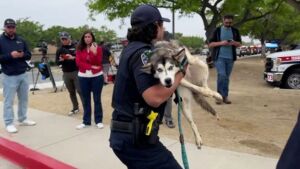 from the crash site, said he and his wife were awakened by a loud bang. They grabbed their three young boys and ran out of the house. On their way out of the neighborhood, they saw a car engulfed in flames.
from the crash site, said he and his wife were awakened by a loud bang. They grabbed their three young boys and ran out of the house. On their way out of the neighborhood, they saw a car engulfed in flames.
“It was definitely horrifying for sure, but sometimes you’ve just got to drop your head and get to safety,” he said.
Police officers rescued multiple animals, including three husky puppies that were rolled away in a wagon. A few blocks away, families, including Moore's, stood in a parking lot waiting to learn when they could return to their homes.
The weather may have played a role in the crash
Eddy said it was very foggy at the time the private plane crashed in the neighborhood about 2 miles from the Montgomery-Gibbs airport. “You could barely see in front of you," he said.
City Councilmember Raul Campillo said residents told him dramatic stories “about military families helping military families out of their homes, jumping out of windows and avoiding fire.”
The FAA said the NTSB will lead the investigation.
At that hour and in foggy weather, the plane was likely operating on an instrument flight rules plan, which is typically used during reduced visibility, said Barry Newman, a board-certified aviation attorney.
However, for that airport, once the aircraft reaches 673 feet, the pilot also has to rely on his sight.
“If a pilot descends to that level and he can’t see the runway, he has to call for a missed approach or divert to another airport,” Newman said.
In October 2021, a twin-engine plane plowed into a San Diego suburb, killing the pilot and a UPS delivery driver on the ground and burning homes. It was preparing to land at the airport.
In December 2008, a U.S. Marine Corps fighter jet slammed into a house in San Diego’s University City neighborhood, causing an explosion that killed four people inside. The Marine Corps blamed the crash on mechanical failure and human error.
Associated Press journalists Javier Arciga in San Diego; Christopher Weber in Los Angeles; Kathy McCormack in Concord, New Hampshire; Maryclare Dale in Philadelphia; and Josh Funk in Omaha, Nebraska, contributed to this report.
https://www.nbcsandiego.com/news/local/san-diego-plane-crash-what-we-know/3831940/
1 rescued from B.C. plane crash with help from parachute team aboard Canada’s new SAR plane
by Adam Chan
A woman was rescued from a plane crash near Prince George on Wednesday with help from a search and rescue (SAR) team from 19 Wing Comox, who parachuted out of the Royal Canadian Air Force’s brand new Kingfisher SAR plane.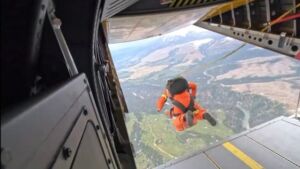
The rescue marked the first operational parachute jump for the CC-295 Kingfisher aircraft, which only entered full operational service in Canada on May 1 at 19 Wing Comox.
The team was called to the crash by Joint Rescue Coordination Centre Victoria around 1:30 p.m. after a signal was sent from the pilot’s spot beacon about 72 nautical miles (133 kilometres) northeast of Prince George.
Captain Greg Harris was the pilot on the 295 Kingfisher during the rescue, and Master Cpl. Alain Goguen was one of the two SAR techs who parachuted out of the plane to reach the downed pilot.
They say the rescue was made complicated by difficult weather, but that communication was strong between them, JRCC, an RCMP helicopter that was deployed to the scene and a Cormorant helicopter that was also sent over from 19 Wing Comox.
Multiple crews wade through stormy weather
The Kingfisher and RCMP helicopter were the first to arrive at the crash site, but the stormy weather prevented the plane from getting near the pilot. The RCMP helicopter, however, could move more slowly through the storm and get to the crash site, according to Harris.
“Unfortunately the RCMP helicopter only had the capability to deliver basic first aid, whereas our SAR techs are substantially more capable than that,” he said.
RCMP decided to land near the patient, where they were able to remove her from the wreckage.
“Then we made the decision that our two SAR techs would jump out of the back,” said Harris, adding that the SAR techs could provide a higher level of care until the Cormoront helicopter arrived, which would be large enough to transport the patient and first responders to hospital.
Goguen said the stormy weather did make things more difficult for the jump, noting that hail started to fall after they landed, but that SAR teams train for all conditions.
He added that Wednesday was far from his first jump.
“So it’s kind of a common thing, it just hasn’t happened a lot in B.C. in the last couple years, but there’s been quite a few missions in B.C. for parachuting SAR techs to the ground,” he told CHEK News on Thursday.
Benefits of new Kingfisher
Both the pilot and SAR tech say the new CC-295 Kingfisher is a big leap for search and rescue technology in Canada.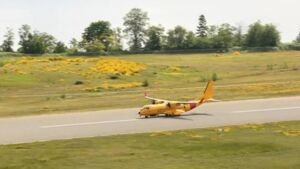
This model of aircraft is replacing the RCAF’s previous search planes, the CC-130H Hercules, which were built in the 1950s and entered service in the Royal Canadian Air Force in the 1960s.
In 2016, Canada signed a $2.4 billion contract for a fleet of Kingfishers, which were initially supposed to roll out in 2020 but were pushed back because of the COVID-19 pandemic, when prices also rose to $2.9 billion.
The new cameras and technology aboard the Kingfishers were a main selling point, the military said at the time, and Harris says the difference is significant.
“I was previously a search and rescue pilot on the Buffalo for a period of time, and then I got to transition to this new one, so I’ve seen the changes in capabilities firsthand,” he said.
“The Buffalo was really a legacy airplane. You know, old school flying, sensors were limited, the avionics were limited, etcetera,” he said. “This one is like comparing a 1967 Chevy to a self-driving Tesla.”
“The avionics are absolutely incredible, the cameras and sensors to enable faster searching is just a complete game-changer,” he said.
The pilot says the improved technology not only speeds up searching but makes it safer for crews on board as well.
He says the new cameras can zoom in incredibly close to the ground, “to the point where we can see the name brand on your ballcap, for example,” meaning SAR techs who parachute out of planes have a better sense of what the terrain looks like beneath them.
“Whereas before that wasn’t the case, all we had was our eyeballs from pretty high up,” said Harris.
Goguen says it also makes it faster to prepare for a jump.
“(You have to) figure out the altitude of the jumpzone to set your parachute, we have systems that will fire reserves if something bad happens to us in the air or something like that,” he said. “So the new aircraft has a lot of capabilities that enable us to do that quite faster in a lot of circumstances, so we kind of got out just before the storm got really bad.”
He adds that Wednesday’s rescue was a good stress test for the new equipment, and set a good start for the use of Kingfisher planes across the country.
“So this was good, like the mission had a good outcome, and good for us to take some of those things into the future for scenarios that are similar,” he said.
“So it’s kind of a double whammy where we got to use our new equipment and the outcome was good for the patient as well.”
Back in 2020, when the Kingfisher SAR planes were initially announced, the military said five CC-295’s would be based at 19 Wing Comox.
Additional Kingfishers are also expected at 14 Wing Greenwood, NS – 17 Wing Winnipeg, Man. – and 8 Wing Trenton, Ont., though the rollout timeline has not been finalized yet.
NTSB Prelim: Piper J3C-65
Pilot Told His Friend That The Airplane Had A Slight Rightturning Tendency When He Let Go Of The Control Stick
Location: Wilson, KS Accident Number: CEN25FA166
Date & Time: May 4, 2025, 13:25 Local Registration: N98416
Aircraft: Piper J3C-65 Injuries: 1 Fatal
Flight Conducted Under: Part 91: General aviation - Personal
On May 4, 2025, about 1325 central daylight time, a Piper J3C-65 airplane, N98416 was destroyed when it was involved in an accident near Wilson, Kansas. The pilot was fatally injured. The flight was operated under the provisions of Title 14 Code of Federal Regulations Part 91 as a personal flight.
The accident airplane and another airplane, piloted by the pilot’s friend, departed Eck Field (SN64) near Goddard, Kansas, and proceeded to Lucas Airport (38K) in Lucas, Kansas, 94 nm southeast of SN64. The pilot and his friend had lunch at 38K and then departed back to SN64. On the way back to SN64, they planned to stop at Lyons Airport (LYO) near Lyons, Kansas, to refuel.
According to the pilot’s friend, after their lunch at 38K, they checked the fuel and oil in their respective airplanes, determined that the amount of fuel and oil were sufficient, departed 38K, and proceeded towards LYO.
According to the pilot’s friend, they were in a shallow climb on a southeast heading about 1,200 to 1,500 ft above ground level when the friend witnessed the accident airplane bank to right, in a nose low attitude. The bank continued to increase, and the nose low attitude steepened until the airplane impacted the ground in a near vertical, nose down attitude. Before the accident airplane banked to the right, the friend said they were talking on the radio and nothing seemed amiss. At no time during the accident sequence did the pilot issue a distress call.
The airplane impacted a grassy field about 17 nm southeast of 38K. The airplane traveled about 45 ft from the initial impact site to the main wreckage and came to rest inverted on a heading of about 186°. At the initial impact site was a piece of fabric-covered wood from the right wingtip embedded in the ground. Debris followed the piece of wood in a straight line on a 266° heading. The debris field consisted of metal wing spars, plexiglass, and a large piece of fabric from the right wingtip. The engine, the damaged propeller attached at the hub, header fuel tank, instrument panel, and airplane door were located about 25 ft after the initial impact site. The header fuel tank was crushed and breeched. No fuel was present in the header fuel tank. The main wreckage was located about 20 ft from the engine. The main wreckage consisted of the fuselage, wings, and vertical and horizontal stabilizers.
About 2 years before the accident, the pilot told his friend that the airplane had a slight rightturning tendency when he let go of the control stick during flight, so he had to keep constant left pressure on the control stick to keep the airplane straight and level. His friend said the pilot did not seek to fix the problem because it was not too much of a concern. The friend flew the accident airplane and confirmed the right turning tendency; however, he said the right turning tendency was controllable while holding left pressure on the control stick.
The airplane wreckage and engine were retained for further examination.
FMI: www.ntsb.gov

Today in History
54 Years ago today: On 23 May 1971 Aviogenex flight 130, a Tupolev Tu-134, crashed following a heavy landing at Rijeka Airport (RJK), Croatia. Just five of the 83 occupants survived the crash.
| Date: | Sunday 23 May 1971 |
| Time: | 20:00 |
| Type: | Tupolev Tu-134A |
| Owner/operator: | Aviogenex |
| Registration: | YU-AHZ |
| MSN: | 1351205 |
| Year of manufacture: | 1971 |
| Total airframe hrs: | 111 hours |
| Cycles: | 47 flights |
| Engine model: | Soloviev D-30-II |
| Fatalities: | Fatalities: 78 / Occupants: 83 |
| Other fatalities: | 0 |
| Aircraft damage: | Destroyed, written off |
| Category: | Accident |
| Location: | Rijeka Airport (RJK) - Croatia |
| Phase: | Landing |
| Nature: | Passenger - Non-Scheduled/charter/Air Taxi |
| Departure airport: | London-Gatwick Airport (LGW/EGKK) |
| Destination airport: | Rijeka Airport (RJK/LDRI) |
| Investigating agency: | DGAC Yugoslavia |
| Confidence Rating: | Accident investigation report completed and information captured |
Narrative:
Aviogenex flight 130, a Tupolev Tu-134, crashed following a heavy landing at Rijeka Airport (RJK), Croatia. Just five of the 83 occupants survived the crash.
The aircraft, operating on a charter flight from London-Gatwick Airport (LGW), approached Rijeka in poor weather with heavy cumulo-nimbus, heavy rainfall and severe turbulence about 4 km from the runway threshold. As the aircraft passed through the area, it was carried upwards and rolled to the right. The aircraft was now above the ILS glide path. Some 800 m short of the runway, at a height of 60 m the crew decided to continue the approach. Power was reduced and the angle of descent increased to 10 degrees. The aircraft struck the runway with the right main gear at an airspeed of 260 km/h with 4g deceleration force. The right wing detached and the plane rolled on its back. The remaining stub of wing folded to block the overwing emergency exit. The aircraft slid for 700 m and caught fire.
PROBABLE CAUSE:
It is considered that the probable main cause of the accident of the TU-134A aircraft, registration marks YU-AHZ, which occured on the 23rd May, 1971, at "Rijeka" airport was a heavy landing on the right leg of the main landing gear, emphasised by an irregular position of the wheels and 0.7% slope up of the runway at the point of touchdown.
The Commission consider that the described deviation from the flight tehnique in itself, did not cause the crash of the aircraft, but that loading which resulted from the conditions under which the landing was performed made a greater contribution to the crash.
However, non-adequate handling of controls of the aircraft and engines could be explained only by false perceptions (illusions) of the crew concerning the aircraft position in respect to the runway.
The last minute of the flight was analysed on the basis of:
- flight recorder oscillogram
- results obtained during the investigation on the flight on board of the same type of aircraft.
- study of aerodynamic characteristics and stability of TU-134A - analysis of meteorological situation
- analysis of crew members' statement
According to the opinion of the Commission this was an exceptional and complex case of many unfavourable circumstances which resulted in this catastrophy.
